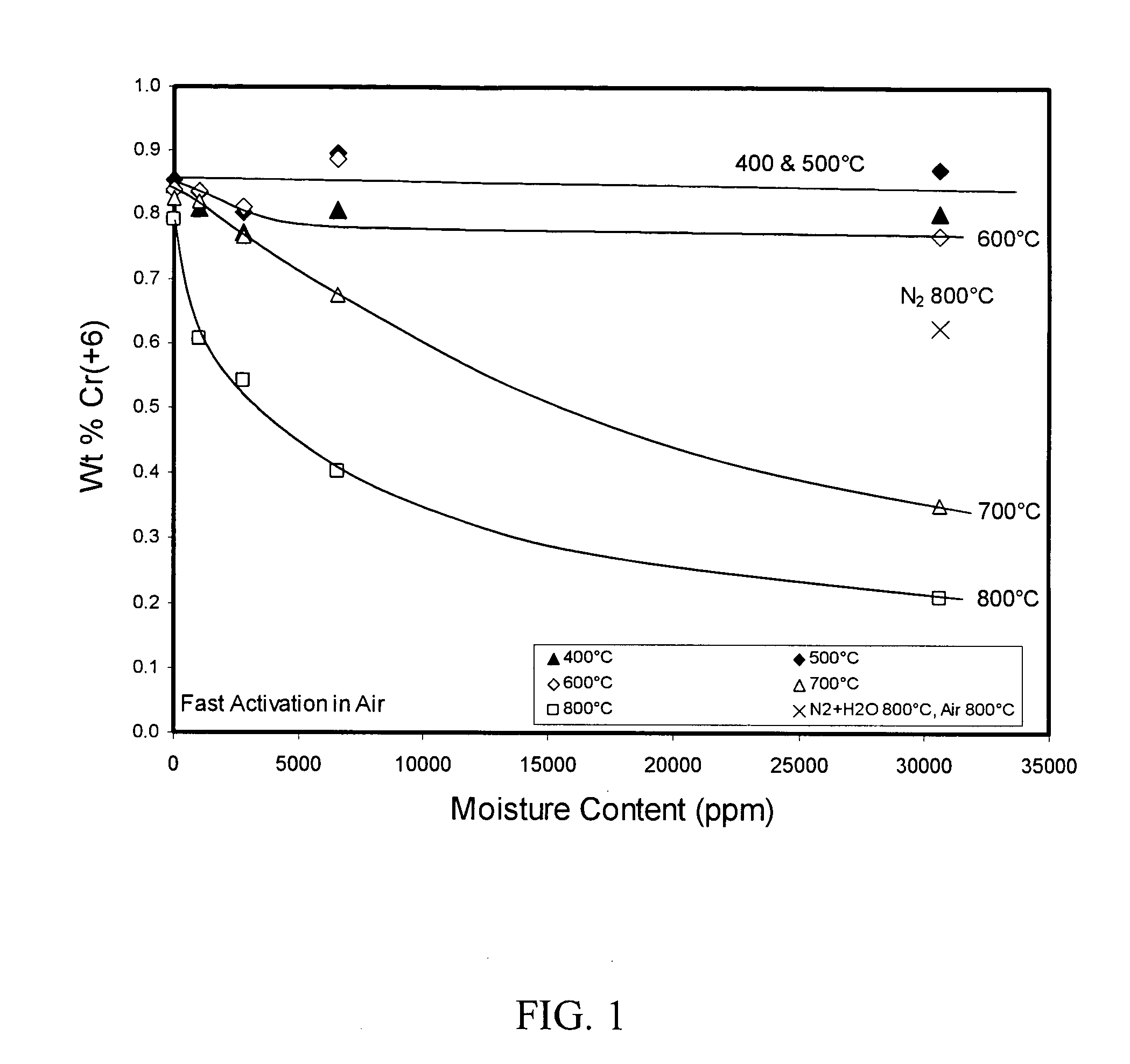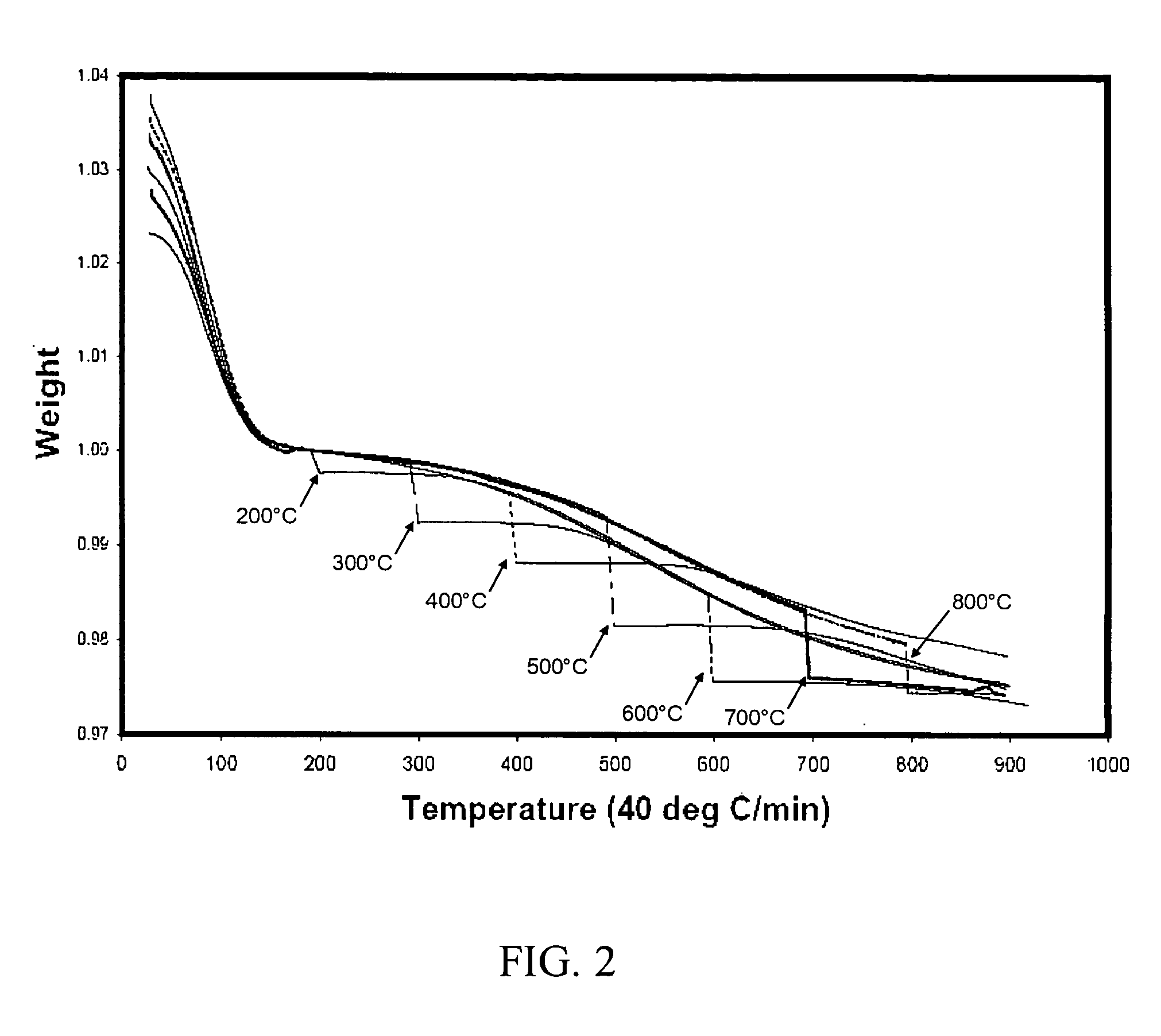Methods of activating chromium catalysts
- Summary
- Abstract
- Description
- Claims
- Application Information
AI Technical Summary
Benefits of technology
Problems solved by technology
Method used
Image
Examples
example 1
[0050] A laboratory procedure was designed to reproduce the longer procedure used for commercial activations. In a commercial process, about 600-750 lbs (272 to 340 Kg) of catalyst was introduced or charged to a vessel having a grid plate 42 inches (1.1 meters) in diameter. Dry air or other oxidizing atmosphere was blown up through the plate to fluidize the catalyst. Air was introduced at about 0.15 ft / sec (4.6 cm / sec), and the ramp up time, or period of increasing temperature, typically took about 10 hours to reach 800° C. Longer ramp up times can be used commercially to compensate for the increased moisture generated when proportionally deeper beds of catalyst are used. The larger catalyst charge releases more moisture, which can damage the catalyst. To compensate, the moisture release that accompanies the temperature rise is diluted in more air by slowing down the ramp up rate.
[0051] To reproduce commercial conditions for the laboratory studies, moisture was deliberately added t...
example 2
[0061] To study the effect of moisture, the catalyst was dropped into a hot activator tube containing nitrogen at 30,000 ppm moisture instead of the atmosphere of air used in the previous test. After 15 minutes exposure, the atmosphere was then changed to dry air, and the catalyst was exposed for an additional 15 minutes. Results shown in FIG. 1 demonstrate that the Cr(+6) stabilization for the catalyst in this test was much higher in the activated catalyst than it was in a corresponding catalyst treated at 800° C. in air when both catalysts were treated at the same moisture level. Without intending to be limited by theory, it is believed that nitrogen protects the catalyst and that large crystallites of alpha-chromia grow more easily when traces of oxygen are present with moisture. [See Excess Oxygen of Chromia, I.; by M. P. McDaniel and R. L. Burwell, Jr.; Journal of Catalysis, Vol. 36, p. 394 (1975), and Excess Oxygen of Chromia, II. Reaction with Diphenylpicrylhydrazine; by M. P...
example 3
[0062] Thermogravimetric analysis was performed to determine the effect of temperature on hold time. The silica from the activated catalyst was subjected to a thermogravimetic analysis. Starting at room temperature each sample was heated in flowing nitrogen at 40° C. per hour up to 900° C. and the weight of the sample was monitored. Each sample lost weight as the temperature was raised, due to the loss of moisture. During each experiment, the temperature rise was halted at various temperatures from 200° C. to 800° C. where it was held for 24 hours. Afterward the temperature rise was continued at 40° C. per hour as before up to a maximum of 900° C. The data was plotted and the curves are shown in FIG. 2. The break in the curve represents the 24 hr isothermal hold period. The silica lost the most weight during the time when the temperature was halted at 500-600° C. This suggests that molecular motion begins to accelerate at that temperature. At still higher temperatures, the molecular...
PUM
| Property | Measurement | Unit |
|---|---|---|
| Temperature | aaaaa | aaaaa |
| Temperature | aaaaa | aaaaa |
| Temperature | aaaaa | aaaaa |
Abstract
Description
Claims
Application Information
 Login to View More
Login to View More - R&D
- Intellectual Property
- Life Sciences
- Materials
- Tech Scout
- Unparalleled Data Quality
- Higher Quality Content
- 60% Fewer Hallucinations
Browse by: Latest US Patents, China's latest patents, Technical Efficacy Thesaurus, Application Domain, Technology Topic, Popular Technical Reports.
© 2025 PatSnap. All rights reserved.Legal|Privacy policy|Modern Slavery Act Transparency Statement|Sitemap|About US| Contact US: help@patsnap.com



